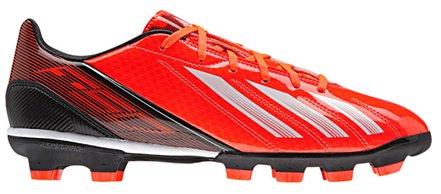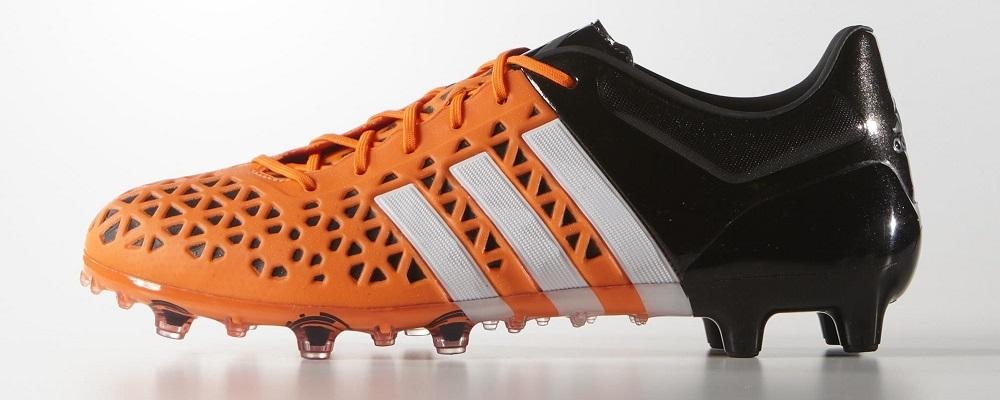Football boots must be chosen correctly and for this, the field where the game or training will be held is taken into account. This is where you can get the results you want. In addition, such an element should be comfortable for a football player, not interfere with the control of the ball, and also provide additional protection for the leg in order to exclude possible injuries. The article describes tips and basic parameters on how to choose the right boots, as well as compiled the main types that are used in football.
Content
Boot selection options
To understand how to choose the right football boot, it is important to understand a few basic parameters. Among them are not only size and comfort, but also the main materials from which the shoes are made, as well as the features of the studs.
Top material
A leather upper works best for boots. Such raw materials are soft, perfectly breathable, and makes it possible to feel the ball with your foot. When choosing, remember that the leather is stretchy, so the upper part should be tight in girth, especially if the raw material is light and elastic (kangaroo leather). In the case of raw calf, the shoes will be stiffer, but several times cheaper. Other materials include:
- For playing in or after the rain, when the grass is wet, a PU upper is best. The material is lightweight, allows you to retain moisture and does not let it through to the inside of the leg.
- Suede has the same advantages as leather, but the shape will last longer, and the shoe does not stretch very much.
The textiles are lightweight and highly durable. It is recommended to buy for training in the gym, but this option is not suitable for outdoor play. - The synthetics help to reduce the overall weight of the boot and will also last a long time, even under heavy loads. But such material must be chosen strictly in size, since the raw material does not stretch and cannot adapt to the anatomy of the leg.
Sole
At the moment, manufacturers use 2 main materials for the outsole:
- Polyurethane is a lightweight and durable raw material that provides optimal mobility for the leg on one side, and on the other, it provides protection from the stresses while running.
- Rubber - has good shock absorption and low cost, but the rubber itself wears out quickly and is not suitable for training in the gym on the floor.
The size
Football shoes are purchased in a different size, which will be different from everyday ones. This is due to the fact that the legs swell during training or hours of games, often football players use leggings, tight socks. Due to this, you need to buy models 1-1.5 sizes larger, subject to a hard top, but natural materials can be supplied in sizes.
Thorns
Spikes are made of similar materials as the sole, and plastic and metal inserts are used for manufacturing. When choosing, you need to look at the shape, and the main materials are determined later.
There are many variations to choose from, but the following are the most effective:
- Tapered - great for people looking for a high degree of stability, as well as maximum safety of the legs from injury in the event of a fall.
- Flat - footballers call it a blade or fin.They are perfect for running on a dirt field, give the best speed, but if the surface is hard and the spikes will not sink in, then there are risks of damaging the ankle joint.
- Round - modern shape, best suited for artificial grass, often includes additional holes that increase cushioning.
- Boomerangs are the best acceleration spikes.
- Hexagons - make it possible to make the most accurate strikes, and are also comfortable while running.
Which boots to choose
When choosing boots, you should understand the main tasks of a football player on the field. There are some simple tips for this:
- If the game is amateur with friends, then classic centipedes made of artificial upper and rubber soles will be enough.
- For playing on the lawn, it is recommended to take models from the FG or HG series. This is a versatile piece of equipment that is popular and is best bought from natural raw materials.
- For the goalkeeper, models of the SG series with spikes are suitable, which are complemented by metal inserts, but only if football on a natural field.
- For children, centipedes or AG models are suitable. It is these shoes that will allow the leg to develop and form normally. It is best to choose a toe-toe boot. Although the model is new and not considered a classic, it provides a better fit and protection of the joint from damage.
How much are the boots
The cost depends on the shapes and materials. For leather products for playing on the grass, boots will fluctuate in the range of 1.8-16 thousand rubles. If the upper part is made of dermantine, then the price is reduced to 12,000 rubles. For the hall, the options will be in the range of 700-4500 rubles, which also includes centipedes.
Top boot manufacturers
Experienced players know which football boots are the best. There are several brands in the world that produce professional footwear and clothing for sports:
- Adidas;
- Nike.
These companies offer customers the highest quality products, and also release new models annually with the introduction of innovations and other technologies. Football beginners can find it difficult to understand the lineup, so you should explore the possible types of football shoes.
Types of football boots
Football uses different types of boots that differ in their characteristics and are suitable for different surfaces and weather conditions.
Firm ground (FG)

This option is classic and is suitable for playing on real grass. There are a dozen cone-shaped spikes on the outsole. They are made of polyurethane or fluoroplastic. There are more of them near the toe, often about 9 pieces, which makes it possible to perfectly enter soils of different densities, for example, a dry field where natural grass grows.
Pros:
- Excellent tenacity.
- Stability on the field.
- Optimum performance in tall grass fields.
- Sold in any store.
Minuses:
- Studs wear out quickly and cannot be replaced.
- If you play on hard surfaces, the player gets a lot of stress on his legs.
Turf (TF)

Football players call these boots centipedes because they have many small spikes at the bottom. This model is often used for playing on short synthetic grass, asphalt or a simple court. The outsole is made of rubber, which has a high stability, under the insole there is a foam pad to absorb impact.
Pros:
- Great for hard fields.
- The load is evenly and correctly distributed.
- Can be bought for children.
- Optimal cost and availability, models are available in any stores.
If used for grass with high heights, then there is a risk of entanglement in the green with further injuries.
Soft Ground (SG)

These cleats are distinguished by the presence of 6-8 studs in front, which are installed on a threaded connection, so the elements can change with wear. An excellent choice for playing with soft fields or for rain. To improve grip, studs of 12-18 mm are installed, often with steel tips.
Pros:
- High degree of versatility, as the cleats are easily changed and matched to the conditions of the football match.
- Good traction on grass or soft surfaces.
- Excellent speed retention.
- Possibility of replacing studs.
Minuses:
- Not suitable for hard field.
- The appearance of flat feet in children is possible.
Artificial Grass (AG)

Initially, the model was created only for artificial fields. On the lower part there are about 20 spikes of protrusions, which are not full-fledged spikes. Their height is up to 10 mm. The upper is cushioned and the shoe will suit the fields.
Pros:
- They help to properly distribute the mass on the leg.
- Good stability on hard surfaces.
- Shoes for natural or synthetic surfaces are suitable.
- Recommended to buy for children and teenagers.
Minuses:
- Not the most common option, therefore, it can be found quite rarely at points of sale.
- The spikes are small in height, wear out quickly, and cannot be replaced.
Hard Ground (HG)

An excellent option for training, visually the model is almost no different from the FG, but the number of pimples will be 1-2 units more, but the height is less. The difference may seem small, but this makes the boot better suited for hard-surface playing fields and older courts.
Pros:
- The cleats are evenly spaced across the outsole for improved stability when playing on hard surfaces.
- Suitable for a field with worn grass, synthetic materials.
Minuses:
- The spikes cannot be replaced.
- Rapid wear of the studs on the outsole.
Indoor Cleats or Futsal (FS, IN, IC)

This option is called bumpers and they are characterized by a low fit, as well as a flat sole. Recommended for use in a hall or closed areas where the surface of the field is completely smooth. The upper is made of textile, the bottom is very flexible and the general parameters allow for a ball feel.
Pros:
- There is a special element between the sole and the foot to reduce stress on the feet.
- The presence of inserts to improve ventilation of the legs.
- A tread with a complex pattern, which prevents the shoes from slipping on the floor.
- The outsole is resistant to wear, so it will last for a long time, and does not leave marks during running.
The main disadvantage is that they are not suitable for a normal grassy field or unpaved surface.
Tips for choosing boots
Experts have compiled several effective tips that will help you understand how to choose the right football boots for a child or an adult:
- Equipment should be lightweight and durable. Manufacturers make them from leather or dermantine with the thinnest possible walls so that the foot can feel the ball, and the sole will be firm with spikes, but you need to look for it to have optimal flexibility and resilience.
- The best boots are made from kangaroo leather, but for kids it is better to choose a more economical model as the foot grows every year. In this case, calf leather or synthetic materials are the best choice.
- Spikes are the main difference between football shoes. Professional players have different options in stock, based on the field, weather conditions. Difference in size, shape of spikes and materials. On artificial and natural fields, it is better to use 10-15mm high plastic spikes with 4 spikes at the heel and 9 at the front. In case of rain, elements with a duralumin tip or flat plastics in the size of 15-18 mm are suitable. The quantity is less than the standard and more location on the edges. If the field is natural, but the grass is rarely used multi-stud with rubber elements. Playing indoors or on flat surfaces involves using a complex tread.
- 6 and 8 spike shoes are not used by children under 16. It causes severe stress on the foot and can cause deformity of the legs, flat feet.
- Genuine leather always stretches during use, therefore, during fitting, the finger can be pressed against the front wall, but not much. After 3 sessions, everything is normalized. Before playing for the first time in new shoes, you can slightly wet the shoes to help the foot adapt. If the materials are artificial, then you need to look at the composition in order to accurately select the size, because the raw materials may not stretch.
- For children of school and other ages, it is recommended to buy shoes half the size of each day.It is forbidden to use tight boots.
- It is imperative to use a pair, not just 1 boot, since the legs may differ slightly in size, and if the game is played in socks or leggings, then it is better to try them on.
- It is not uncommon for football to be played in cold weather, so when choosing boots, you need to exclude the use of plastic elements, because they can deform or break. Each pair must have instructions on the conditions and weather of use.
For a long service life of football shoes, the surface should be rinsed and brushed after every game and dried completely. It is forbidden to use heating devices and do not put on the balcony under the sun. After drying, cream or wax can be used.



